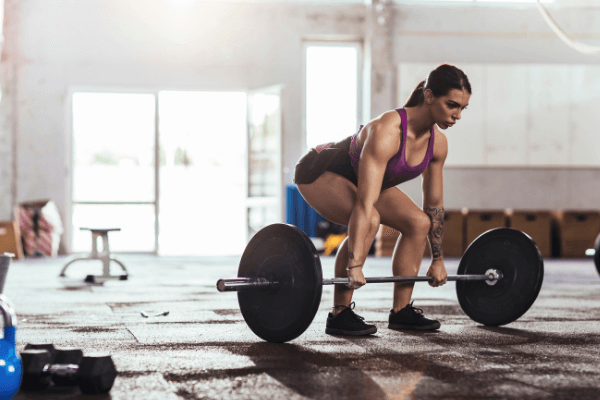1. WOMEN LIFTING WEIGHTS WILL MAKE THEM BULKY
Excess bulk and weight gain come from eating a surplus of calories, not from lifting weights. Consuming more calories than you burn will always tip the scales in the wrong direction, and the longer you stay in a caloric surplus, the more weight you have the potential to gain.
Women, generally speaking, have less than 10% of the resting testosterone levels of a male. This could explain why men possess a greater ability to gain strength and muscle hypertrophy, compared to a female performing at the same relative level.
Testosterone is anabolic in nature and important for muscle growth. Hence, it’s always going to be more difficult for a woman to gain muscle and excess bulk compared to that of her male counterpart.
Excess weight gain that occurs as a result of women lifting weights is more about the overconsumption of food than the training stimulus itself. Weight training improves overall metabolic rate, which spikes appetite — leading to overindulging in excess calories.
Advice:
Weightlifting for women will not cause a bulky appearance; just be careful not to eat a surplus of calories. Over time this will be the cause of your weight gain, not your weightlifting training.
2. CARDIO IS BETTER FOR WEIGHT LOSS
What is metabolism?
It’s the sum of all chemical processes that are occurring in the body at one time.
When you’re at rest, your body’s metabolic rate (BMR) will be at its lowest. In contrast, when you’re working at a high intensity, your metabolism will be functioning at its highest rate.
What is the afterburn effect?
This is the extra energy that your body is expending after a workout; in other words, your metabolic rate immediately after your workout.
The more intense your workout is, the longer the afterburn effect.
The lower the intensity of the workout, the shorter the afterburn effect.
A weightlifting workout for women will have a greater effect on metabolic rate for longer post-session, compared to slower steady-state cardio. The increase from baseline metabolic rate with weight training can last up to approximately 24 hours post-session.
Advice:
Choosing heavier, high-intensity workouts will positively gear your metabolism for longer post sessions. This makes weightlifting a better training option for weight loss (when coupled with an appropriate nutrition plan).
3. WEIGHTLIFTING WORKOUTS FOR WOMEN ARE TOO DANGEROUS:
1. Bone mineral density (BMD) — even when compared to other female athletes in different sports, studies show that BMD is greater in women who perform weightlifting movements.
The stronger your bones are, the less risk of breaks and onset of osteoporosis (a condition where bones become thin and weak).
2. Improved tendon and ligament strength — progressive load through these structures over time thickens the fibres, making them more dense and resistant to tearing and pulling.
3. Improves posture — with all the time people spend at a desk these days, weightlifting can help to strengthen up back extensors and improve posture. When the body is in correct alignment, there is a reduced tendency for compression on nerves and vessels that constrict blood flow and circulation.
Research also shows that injury rates in weightlifting are low compared to other popular sports.
The benefits seem to steer in favour of weightlifting having more of a positive impact on female health. With good technique and programming, weightlifting for women has a relatively low risk of being dangerous.
Advice:
The benefits for females lifting weights far outweighs the risk. Find a coach and program that suits your needs. Never be fearful of something that can have a positive impact on your health and well-being.
4. HIGH REPS AND LOWER WEIGHTS ARE BEST FOR FEMALES LIFTING WEIGHTS
As mentioned previously, higher intensity workouts will have a longer afterburn effect when compared to lower intensity, lighter training sessions.
Advice:
Don’t associate longer, low-intensity steady-state training sessions with weight loss and muscle tone.
The key lies in high intensity, heavier sets. This is where the metabolic shift happens and where you burn more calories for longer after a training session.
5. WOMEN LIFTING WEIGHTS IS NOT ATTRACTIVE
A time did exist when the gym and weightlifting were more commonly associated with brawny males. However, these days it’s not unusual to see women throwing down in the weight room alongside men.
Anyone that’s ever told you — or a female you know — that women lifting weights is not attractive is subconsciously saying one of two things:
- ‘I could never do this myself, so I will enforce my own insecurities onto you.’
- ‘I’m embarrassed that you’re able to lift more than me.’
There are fewer things more empowering for a woman’s self-confidence than throwing down with some heavy weights.
Advice:
Go hard in the gym, lift heavy weights and don’t listen to anything negative that anyone has to say about women and weight lifting.
Anyone who tells you it’s not attractive has their own insecurities, and those issues aren’t yours.
TO WRAP UP
1. Weight training for women will not cause bulkiness, but overeating will.
2. Lifting weights has a better effect on your metabolic rate than slow steady-state cardio — making weight loss and muscle tone more attainable in conjunction with good nutrition.
3. Weight training has more positive effects on the body than negative. Poor form and overtraining are what’s dangerous — and it doesn’t bias gender.
4. Lower reps at higher intensities have a greater afterburn effect on your metabolic rate, helping you burn calories for longer post-session.
5. Weightlifting for women is attractive and builds self-confidence and self-worth. Haters are always going to hate when you’re doing things they can’t do.

